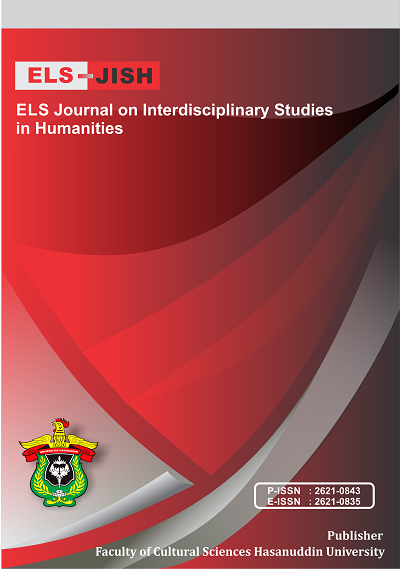Dixon’s Framework Model of Think Verbs in English and Wawonii Language
DOI:
https://doi.org/10.34050/elsjish.v5i4.24817Keywords:
Dixon’s Framework, Think Verb, Semantic, Wawonii LanguageAbstract
The aim of the current study is to examine the employment of the Think verbs in English and Wawonii language, employing Dixon’s framework model of semantic and grammatical relations. In analyzing the phenomenon of the Think verbs in English and Wawonii, this study uses a descriptive qualitative methodology. The data for English is taken from a corpus of contemporary American English (COCA), including the definition of the conceptual meaning of the Think verbs in a thesaurus dictionary and Journals. The Wawonii language data is obtained through depth online interviews. The participants are 10 indigenous Wawonii people in Kabupaten Konawe Kepulauan, Southeast Sulawesi, Indonesia. Several procedures are applied to analyze the data; first, the data for the English language from COCA is constructed with the data of the Wawonii language that had been collected. Then, presenting both of the data based on Dixon’s framework model. The final step is concluding the data reflecting the main point of the analysis relying on Dixon’s framework model. This study discovered that (1) There are three Thinking verbs of the Think subtype in English they are Think of, Think over, and Think about, while in the Wawonii language, there are six Think verbs; Mepikiri Kanaampe, Pepikiri kida, Tepikiri kio, Kohawa-hawa Kanaampe, Momaana, and Mompatudu. (2) Dixon’s five framework model of Think verbs is employed in both languages. This study contributes to the language and society to enrich a variety of works of literature that can be used to learn English and the Wawonii language.
References
Arunachalam, S., & Waxman, S. R. (2011). Grammatical Form and Semantic Context in Verb Learning. Language Learning and Development, 7(3), 169-184.
Aswad, M., Rahman, F., Said, I. M., Hamuddin, B., & Nurchalis, N. F. (2019). A Software to Increase English Learning Outcomes: An acceleration Model of English as The Second Language. The Asian EFL Journal, 26(6.2), 157.
Berti. (2005). The phonetic of Wawonii Dialect. Unpublished Undergraduate Thesis: Unhalu. Kendari Indonesia.
Denzin, N. K., & Lincoln, Y. S. (Eds.). (2011). The Sage handbook of qualitative research. sage.
Dixon, R. M. (2005). A Semantic Approach to English Grammar. Oxford University Press.
Francez, I., & Koontz-Garboden, A. (2015). Semantic Variation and The Grammar of Property Concepts. Language, 533-563.
Halwiah. (2008). Derivational Noun in Wawonii Language. Unpublished Undergraduate Thesis: Unhalu. Kendari Indonesia.
Holyoak, K. J., & Spellman, B. A. (1993). Thinking. Annual review of psychology, 44(1), 265-315.
Israa, B. A. (2019). Semantics. English Department. Tikrit University.
Jackson, H. (2014). Grammar and Meaning: A semantic approach to English grammar. Routledge.
Katz, J. J. (1972). Semantic Theory.
Klein, T. (2022). Does Preverbal Old English Ge-Have Semantic or Aspectual Force?: evidence from the Dictionary of Old English. Studia Neophilologica, 1-18.
Maharani, P., Yassi, A.H., & Rahman, F. (2022). English Linguistics Theory for subtype complementary feature in comparison to Javanese Linguistics. AMCA Journal of Community Development, 2(2) 42-47.
Mead, D. (1998). The Proto Bungku Tolaki Language. Houston. Texas: Umi Company
Sain, Y., & Syarif, A. R. (2020). Derivational Process of Wawonii Language. IDEAS: Journal on English Language Teaching and Learning, Linguistics and Literature, 8(1), 207-220.
Schneider, D., & Witbrock, M. J. (2015, May). Semantic Construction Grammar: Bridging The NL/Logic divide. In Proceedings of the 24th International Conference on World Wide Web (pp. 673-678).
Scontras, G., Degen, J., & Goodman, N. D. (2017). Subjectivity predicts adjective ordering preferences. Open Mind, 1(1), 53-66.
Xiang, D., & Liu, C. (2018). The Semantics of MOOD and The Syntax of The Let’s-Construction in English: A Corpus-based Cardiff Grammar Approach. Australian Journal of Linguistics, 38(4), 549-585.
Weda, S., Atmowardoyo, H., Rahman, F., & Sakti, A. E. F. (2021). Linguistic Aspects in Intercultural Communication (IC) Practices at A Higher Education Institution in Indonesia. Eroupean Language Scientific Journal, 14, 2-6.
Additional Files
Published
Issue
Section
License
Copyright (c) 2022 Mirdad Mirdad, Harlina Sahib, Karmila Mokoginta

This work is licensed under a Creative Commons Attribution-NonCommercial-ShareAlike 4.0 International License.






